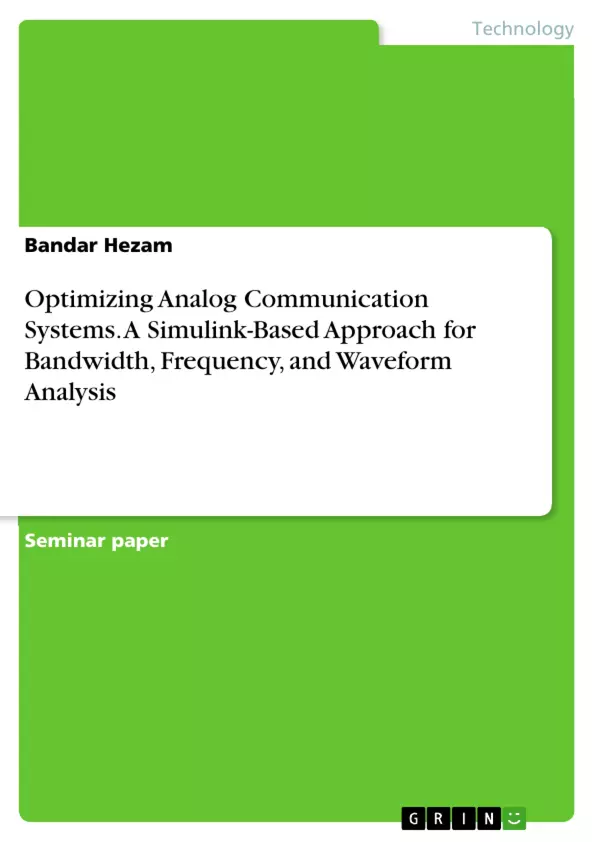Communication systems play a pivotal role in human life, serving as the conduits for information exchange across diverse realms. This paper delves into the intricacies of communication systems, categorizing them based on power efficiency, cost-effectiveness, and wide-band efficiency. Building on the seminal work of Hanzo, Webb, and Keller (2000), the study emphasizes the fundamental components of sender and receiver within communication systems, crucial for both analog and digital transmissions.
The research focuses on the practical implementation of communication systems, employing Simulink as a powerful software tool. The study employs a comprehensive block diagram to illustrate the core components of a Communication System, emphasizing the critical role of Simulink in simulating and controlling analog communication systems. Through this approach, the paper investigates key characteristics such as bandwidth, frequency, and waveform, providing insights into baseband, modulation cases, and construction scenarios. The integration of Simulink facilitates a deeper understanding of the system's behavior and performance, offering valuable implications for optimizing analog communication systems in real-world applications.
Table of Contents
- Acknowledgments
- List of figures
- Introduction
- Introduction to MATLAB & Simulink
- Objective
- Introduction to amplitude modulation
- Modulation Index (m) and frequency spectrum
- Procedures according to using Simulink
- Double Sideband-Large Carrier Transmitter (DSB-LC)
- Procedures
- Results
- Observing the waveforms and the frequency spectrum
- Calculate the modulation index (m) of the AM signal. Record the amplitude of the carrier, upper sideband and the lower sideband
- Change the audio signal and carrier signal parameters to obtain the modulation index of 0.4 and 0.8
- Calculate the power carried by the carrier and the sidebands
- Complete the Simulink model of the AM communication (DSBFC) system by adding receiver model. Capture the input and output waveforms and compare them
- Add an AWGN block to the system and observe the receiving signal quality by setting Different SNR values
- Modify the system to communicate Double Sideband- Suppressed Carrier (DSB-SC) and Single Sideband Suppressed Carrier (SSB-SC) signals respectively by adding appropriate filters
- Discuss whether it is better to use cascaded single order filters or higher order filter
- Compare the results obtained from this exercise with the theoretical results.
- Discussion
- Conclusion
- References
Objectives and Key Themes
This lab report explores the principles of amplitude modulation (AM) and its implementation in a communication system using MATLAB & Simulink. The objective is to test, examine, and generate an Amplitude Modulation-Double Side Band with Full Carrier (AM-DSFC) signal, and then demodulate the modulated signal to regenerate the original message signal.
- Fundamentals of Amplitude Modulation (AM)
- Double Sideband-Large Carrier Transmitter (DSB-LC) Signal Generation and Demodulation
- Analysis of Modulation Index and Power Distribution in AM Systems
- Impact of Noise and Signal-to-Noise Ratio (SNR) on AM Communication
- Comparison of Double Sideband-Suppressed Carrier (DSB-SC) and Single Sideband Suppressed Carrier (SSB-SC) Techniques
Chapter Summaries
- Introduction: This chapter defines communication as the process of information transfer and explores the components of a communication system. It also introduces the concept of amplitude modulation and its role in transmitting information.
- Introduction to MATLAB & Simulink: This section provides an overview of MATLAB and Simulink as powerful tools for modeling, simulating, and analyzing communication systems.
- Objective: This chapter states the main objective of the lab report: to implement and analyze an AM-DSFC signal using Simulink.
- Introduction to Amplitude Modulation: This section delves into the principles of amplitude modulation, explaining how information is encoded onto a carrier signal.
- Modulation Index (m) and frequency spectrum: This chapter introduces the concept of modulation index and its impact on the frequency spectrum of an AM signal.
- Procedures according to using Simulink: This section outlines the steps taken to implement an AM communication system in Simulink, including the generation and demodulation of the AM-DSFC signal. It also discusses the analysis of the modulation index, power distribution, and the effects of noise.
- Double Sideband-Large Carrier Transmitter (DSB-LC): This chapter focuses on the implementation of a DSB-LC AM transmitter and receiver using Simulink, along with the analysis of the transmitted signal and its frequency spectrum.
Keywords
The key focus areas of this lab report are amplitude modulation, DSB-LC signal generation and demodulation, Simulink, modulation index, frequency spectrum, power distribution, noise, SNR, DSB-SC, and SSB-SC communication techniques.
- Quote paper
- Bandar Hezam (Author), 2019, Optimizing Analog Communication Systems. A Simulink-Based Approach for Bandwidth, Frequency, and Waveform Analysis, Munich, GRIN Verlag, https://www.hausarbeiten.de/document/1426542


